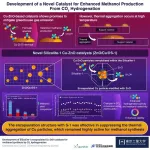(Press-News.org) In a new study, investigators from McLean Hospital (a member of Mass General Brigham), Harvard Medical School and the National Institute on Drug Abuse – Intramural Research Program (NIDA-IRP) discovered that the tendency of people’s arousal to wane over the course of brain scans has been distorting the brain connection maps produced by functional magnetic resonance imaging (fMRI). The team found that as people’s arousal levels dwindle during an fMRI, such as if they become more relaxed and sleepy, changes in breathing and heart rates alter blood oxygen levels in the brain — which are then falsely detected on the scan as neuronal activity.
“You’re laying down in a snug scanner for quite some time, often with only a low-engagement button press task to attend to or nothing to do at all, as the scanner monotonously hums and vibrates around you,” said first author Cole Korponay, PhD, a research fellow at the McLean Hospital Imaging Center. “These arousal-dampening conditions create the illusion that people’s brain connection strengths continuously inflate throughout the scan" to help better connect the ideas.”
fMRI scans are commonly used to non-invasively map brain connectivity in a variety of situations, including planning for surgery, understanding the impact of a stroke, and studying how mental illness affects neurological function. However, since fMRI relies on changes in brain blood oxygen to indirectly measure neuronal activity, it is vulnerable to “noise” from other processes that can affect blood oxygen – such as changes in breathing and heart rates. And because breathing and heart rate patterns are closely tied to arousal levels, changes in arousal can introduce significant noise into fMRI data. Problematically, the conditions of an fMRI scan tend to progressively lull people into lower arousal states.
In the present study, the research team identified a specific blood flow signal that seemed to track both the decline in subject arousal levels and the illusory inflation of functional brain connection strengths. This non-neuronal, physiological noise signal – termed the “systemic low frequency oscillation” (sLFO) signal – grew over time during scanning, in a spatial and temporal pattern that tightly matched the pattern of the connection strength increases. The researchers then demonstrated that a method called RIPTiDe, developed by co-senior author Blaise Frederick PhD, an associate biophysicist at the McLean Imaging Center, to remove the sLFO signal from fMRI data, was able to eliminate the illusory connection strength increases.
“By adopting this sLFO denoising procedure, future studies can mitigate the distortive effects of arousal changes during brain scans and enhance the validity and reliability of fMRI findings,” said Korponay.
This research was supported by the National Institute on Drug Abuse, the National Institute of Mental Health, and the National Institute on Aging, all part of the National Institutes of Health, under grant award numbers 5R01DA039135-06, 1RF1MH130637-01, and 1R21AG070383-01.
in Nature Human Behaviour.
END
Dwindling arousal levels during brain scans have been distorting fMRI results, study shows
Researchers discover a significant problem in brain imaging and identify a fix
2024-06-19
ELSE PRESS RELEASES FROM THIS DATE:
New Czech company linked to IOCB Prague to enter global gene therapy field
2024-06-19
Technology from the laboratories of IOCB Prague has been given an extraordinary opportunity to succeed in the rapidly developing segment of gene therapy. The results of successful research are set to be advanced by a newly established private company called Adalid Sciences, which is being supported with a major investment from BTL Group, a leading manufacturer of medical technologies.
The story begins with the discovery of new lipid nanoparticles with a comic book name coined by Dr. Petr Cígler and Dr. Klára Grantz Šašková of IOCB Prague. Acting as a sort of imaginary courier, their XMAN is capable of safely ...
New findings: East Palestine train derailment caused chemical pollution falling to the earth surface across the US and beyond
2024-06-19
A new study published in the academic journal Environmental Research Letters, reveals that the environmental impact of the February 3, 2023, Norfolk Southern train accident in East Palestine, Ohio covered a very large geographical area. Inorganic pollutants released due to the accident were found in wet weather downfall (wet deposition) from the Midwest through the Northeast reaching as far as southern Canada and North Carolina. The findings are significant as many inorganic pollutants in rain and snow have chemical effects on - aquatic flora and fauna. According to the paper, these pollutants spread over at least portions of 16 states and an area of 1.4 million ...
Interaction with insects accelerates plant evolution
2024-06-19
A team of researchers at the University of Zurich has discovered that plants benefit from a greater variety of interactions with pollinators and herbivores. Plants that are pollinated by insects and have to defend themselves against herbivores have evolved to be better adapted to different types of soil.
Plants obtain nutrients and water from the soil. Since different soil types differ in their chemical and physical composition, plants need to adapt their physiology to optimize this process on different soil types.
This evolutionary ...
More effective cancer treatment with iontronic pump
2024-06-19
When low doses of cancer drugs are administered continuously near malignant brain tumours using so-called iontronic technology, cancer cell growth drastically decreases. Researchers at Linköping University, Sweden, and the Medical University of Graz, Austria, demonstrated this in experiments with bird embryos. The results, published in the Journal of Controlled Release, is one step closer to new types of effective treatments for severe cancer forms.
Malignant brain tumours often recur despite surgery and post-treatment with chemotherapy and radiation. This is because cancer cells can “hide” deep within tissue and then regrow. ...
Ultrasound beam triggers ‘nanodroplets' to deliver drugs at exactly the right spot
2024-06-19
Conventional drug delivery is often like cracking a nut with a sledgehammer. Whether the drug is swallowed, injected, inhaled, or absorbed through the skin, it ultimately diffuses to most parts of the body, including those where it isn’t needed – or where it even might cause harm.
But what if the delivery could be targeted at exactly the right spot? This would allow the total dose to be dramatically lower, thus minimizing side-effects.
Now, scientists from the US have found a way to perfect a promising, ...
Blessing in disguise: Mycoviruses enhance fungicide effectiveness against plant pathogens
2024-06-19
Osaka, Japan — As detrimental as viruses may sound, they can be helping hands for farmers when it comes to dealing with plant pathogens.
Osaka Metropolitan University scientists have discovered that a mycovirus that infects plant pathogenic oomycete Globisporangium ultimum can increase the latter’s sensitivity to specific fungicides. Their findings could lead to innovative approaches for controlling plant diseases, reducing reliance on chemical treatments, and minimizing agricultural loss.
Their results were published in Microbiological Research ...
A novel signal-amplification system utilizing sumanene-based supramolecular polymers
2024-06-19
Chemical sensors whose signals can be amplified by various triggers hold huge potential in multidisciplinary sciences. However, developing such systems was considered a highly challenging task, until a team of researchers from Tokyo Tech recently came up with a novel signal-amplification system that can be flexibly manipulated by a dynamic allosteric effector or a trigger. This new chemosensor system exhibited exception signal amplification by altering the sumanene monomer concentrations.
Synthetic supramolecular hosts and artificial receptors have found an exciting application in the form of chemical sensors or chemosensors, ...
Transforming inexpensive quinolines into complex drug candidates
2024-06-19
An innovative synthesis strategy opened up the way to 2D/3D fused frameworks using inexpensive quinolines as feedstock, report scientists from Tokyo Tech. By leveraging a light-sensitive borate intermediate, the scientists could transform quinoline derivatives into a great variety of 2D/3D fused frameworks in a straightforward and cost-effective manner. Their findings are expected to enable the synthesis of highly customizable drug candidates.
Quinolines have garnered much attention from chemists wanting to synthesize compounds known as 2D/3D fused frameworks. These complex organic molecules have a lot of medical potential due to their highly ...
Unlocking heart health: advancing noninvasive monitoring in chimpanzees
2024-06-19
Measuring the heart rate of great apes in captivity is essential for both health management and animal studies. However, existing most methods are either invasive or inaccurate. Now, researchers from Japan have investigated the potential of using millimeter-wave radar technology to estimate heart rate from subtle body movements in chimpanzees. Their efforts will hopefully pave the way to better practices and techniques for monitoring heart rates in wild and captive primates.
Just like in humans, heart rate is a critically important and informative vital sign in nonhuman primates. Heart diseases are among the main causes ...
Study uses powerful new ‘digital cohort’ method to understand vaping epidemic
2024-06-19
Tapping into the vast amount of data now available on social media, a new study from scientists at the University of California San Diego introduces a powerful new approach to understanding the nation’s health, in this case the vaping epidemic.
The study, published in the American Journal of Preventive Medicine on June 19, was led by John W. Ayers, Ph.D., from the Qualcomm Institute within UC San Diego.
“Researchers studying social media have tended to analyze the frequency and content of posts,” said Ayers, who is deputy director of informatics at the Altman Clinical and Translational Research Institute, vice chief of innovation in the Division of Infectious ...
LAST 30 PRESS RELEASES:
Empress cicada wings help illuminate molecular structure
Using sound waves to detect helium
Time burden in patients with metastatic breast and ovarian cancer from clinic and home demands
Researchers discover bias in AI models that analyze pathology samples
Scientists ID potential way to prevent brain injuries from triggering Alzheimer's
MASTER 2nd Open Call: Execution period kick-off
Algae for health in food and pharma
Advanced microrobots driven by acoustic and magnetic fields for biomedical applications
Chicago health information leader recognized for raising CPR readiness and blood pressure awareness
The Intimate Animal, a new book from Kinsey Institute Executive Director Dr. Justin Garcia
When blue-collar workers lose union protection, they try self-employment
New video dataset to advance AI for health care
MEA-based graph deviation network for early autism syndrome signatures in human forebrain organoids
New modeling approach sheds light on rare gut disease
Study documents potentially hazardous flame retardants in firefighter gear
Can certain bacteria regulate aging of the immune system and its related alterations?
AI model helps diagnose often undetected heart disease from simple EKG
There are fewer online trolls than people think
Cell membrane fluctuations produce electricity
Jeonbuk National University study shows positive parenting can protect adolescents against self-harm
Surface-engineered ZnO nanocrystals to tackle perfluoroalkyl substance contamination
This new understanding of T cell receptors may improve cancer immunotherapies
A new fossil face sheds light on early migrations of ancient human ancestor
A new immunotherapy approach could work for many types of cancer
A new way to diagnose deadly lung infections and save lives
40 percent of MRI signals do not correspond to actual brain activity
How brain-inspired algorithms could drive down AI energy costs
Gum disease may be linked to plaque buildup in arteries, higher risk of major CVD events
Contrails are a major driver of aviation’s climate impact
Structure of dopamine-releasing neurons relates to the type of circuits they form for smell-processing
[Press-News.org] Dwindling arousal levels during brain scans have been distorting fMRI results, study showsResearchers discover a significant problem in brain imaging and identify a fix








